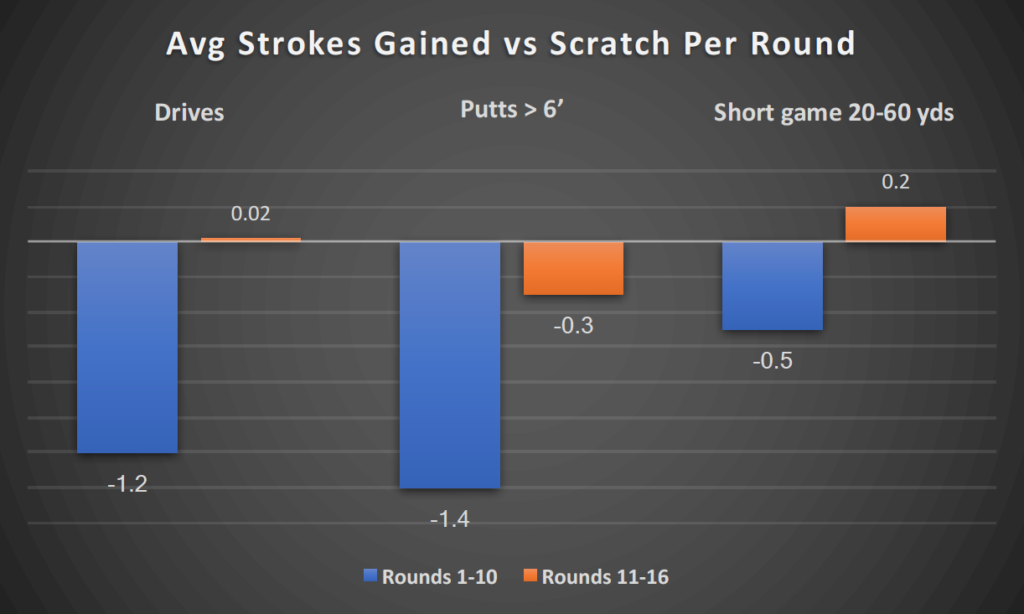
This is a guest post by Sean Denning from the Par Machine
After playing the game for more than 20 years, I finally became a scratch golfer in 2020! My handicap had been in the low single digits for about 15 of those years, but I could never seem to get it all the way down to zero. One of the biggest changes I made, and I think a major factor in my improvement, was using data to make a plan, track my progress, and make adjustments to my practice.
I don’t want to give the impression that data is solely responsible for getting my handicap to scratch. I also worked with a coach on my swing and putting, and I put quite a bit of effort into improving my mental game. But I’ve done that before. I’ve taken lessons and practiced a lot and still didn’t get all the way to scratch. Eventually, I became frustrated and thought maybe I just wasn’t talented enough.
Last year was different. Here’s how data helped me become a scratch golfer.
No Time to Waste
I’m married, have two young kids (one born in the summer of 2020!), and work full-time as a structural engineer. I don’t have an abundance of free time for golf. In fact, I wasn’t sure I should be spending any time on golf.
I hadn’t played well in 2019. My handicap got above 4, and the few tournaments I managed to play had not gone well. I decided I didn’t want to continue taking time away from my family to play mediocre golf. My options were to get better or quit, and I love golf too much to quit.
So I picked a familiar goal - something I had written down as an objective for many past seasons but never achieved - scratch golf. I gave myself 12 months to lower my handicap from 3.3 to 0.0 or better. I knew I would need a plan to use my limited time efficiently.
Traditional Statistics
I started in September 2019 by reviewing my statistics from that season: greens in regulation, fairways hit, and putts per hole. I could get a decent idea of my weaknesses by comparing numbers to past seasons and averages for scratch and pro golfers.
My basic statistics from 2019 and the first ten rounds of 2020 vs. scratch and pro golfers:

All parts of my game needed work. I was hitting 44% of greens, 44% of fairways, had a 30% scrambling rate (percentage of par saves after missing a green), and needed almost 32 putts per round. I knew hitting greens in regulation has a strong correlation to score, and I was pretty sure my short game was holding me back.
I made two sub-goals for the 2020 season: hit 60% of greens in regulation and save par 50% of the time when I missed the green. Those numbers would roughly match GIR and scrambling rates for average scratch golfers. I wasn’t too concerned about hitting fairways, and I thought my putting statistics would work themselves out if I improved my chipping.
Armed with a basic understanding of what I needed to work on, I got started.
Off-Season Work and a Slow Start to the 2020 Season
The Reader’s Digest version of my off-season would go something like this.
- October: I used the short game handicap test from Dave Pelz’s Short Game Bible to decide what I needed to work on most around the green and assess my progress. I spent between five and ten hours per week practicing 15-50 yard wedges and bunker shots.
- November: Another two weeks of short game practice. I also read The Practice Manual by Adam Young in preparation for work on my swing.
- December-January: Five lessons plus five practice sessions at GOLFTEC, mostly working on increasing my hip rotation through impact but also covering putting and a couple of other things.
- February-March: Continued working on swing changes using an indoor simulator two or three times per week. I also read The Ultimate Mental Game Training System for Golf by David MacKenzie.
- April to mid-May: COVID-19 backyard practice! I did more work on swing changes (bought a mat and net), spent some time on Adam Young’s Strike Plan, and did a little chipping around my backyard, all amounting to around five hours per week.
Out of an abundance of caution during the beginning of the COVID-19 pandemic, I didn’t play my first round until May 20th. By the end of June, I had gotten ten rounds in. I was making some progress with ball-striking (GIR and FIR were up to 50% and 51%, respectively), but I seemed to have made practically no improvement on my short game (scrambling at 33%), and my average putts per round had risen to slightly over 32. My handicap had gone up to 3.8, and I was a little concerned.
Strokes Gained Analysis
I wanted to make sure I was doing absolutely everything I could to achieve my goal of a scratch handicap. I wondered if I might be missing something by not using strokes gained analysis.
The general idea of strokes gained analysis is this: instead of judging performance by tracking summary statistics which may or may not correlate to score, track position/distance from the hole of every single shot and calculate if the golfer gained or lost strokes on each shot versus the desired comparison group. It’s then possible to calculate how many strokes were gained or lost during a round to the comparison group in areas such as driving, approach shots, and putting.
A database of golfer performance from various distances and lies (tee, fairway, rough, etc.) is required to make these calculations. There are various products and apps available to do it.
Related Articles: Shot Scope V3 now offers strokes-gained analysis as well as the DECADE app
I decided to try Golfmetrics by Mark Broadie and was impressed with the detailed output. It gave me summaries of strokes gained/lost to an average scratch golfer on drives, approach shots, short game, and putting, as well as detailed breakdowns in each category.

Now I could see exactly how much I needed to improve in each area to play scratch golf. I was losing strokes in these areas:
- Driving: 1.2 strokes per round
- Short Game: 1.0 stroke per round (0.75 from what I would typically consider “short game” inside 60 yards plus another quarter of a shot between 60 and 100 yards)
- Putting: 1.25 strokes per round (inside six feet was slightly better than scratch, but I was losing over 1.4 strokes per round from outside of six feet)
I made some important conclusions from these numbers. Although my scrambling rate of 33% was well below the 52% average for a scratch golfer, Golfmetrics showed I was only losing three-quarters of a shot per round on short game shots inside 60 yards. And the 51% of greens I hit in regulation was well below my 60% goal, but my approach play was actually slightly better than scratch. I could have easily spent the rest of my practice time on my short game and irons and probably come up well short of achieving a scratch handicap. I needed to rethink my practice.
Monitoring Progress and Planning Practice
I realized I needed more practice. Two sessions per week weren’t going to cut it when I needed to improve so many areas with only three and a half more months to hit scratch. So in the last two weeks of June, I started putting in four practice sessions each week (only about 45 minutes each) on top of playing 27 holes.
I spent those practice sessions focusing on the areas where strokes gained analysis showed I was losing the most strokes.
- Drives: David MacKenzie’s “Narrowing Fairway Drill”
- Putting outside six feet
- Worked on improving the tempo of my stroke based on feedback from a GOLFTEC lesson
- Speed control drills from David MacKenzie’s Practice Drills eBook
- Short game 20-60 yards
- I got comfortable making quarter and half swings with each of my wedges and knowing my distances for them
- Played 18 “holes” of up and down with 20-30 yard shots around practice greens
By the middle of July, I could tell those practice sessions had a significant positive impact on my game. A comparison of my strokes gained analysis from the six rounds I played in July showed drastic improvements in the areas I was working on.

Even though my handicap didn’t reflect it yet, my scores and strokes gained analysis showed I had started playing like a scratch golfer. After a short layoff from golf for our new baby (thankfully, I was also able to take a few weeks off work), I continued practicing, and I kept playing well. It didn’t take long for my new playing ability to show up in my handicap.

My handicap dropped steadily from July to October, at last breaking 0.0 with a score of 71 on October 17th! I had missed my 12-month deadline by about two weeks, but the weather held up just long enough for me to cross the finish line. I was finally a scratch golfer!
Takeaways
- Using data helped me get better faster. My handicap dropped from 3.3 to +0.2 in one season. Using data to identify my weaknesses, plan my practice, and track my progress, I could see how my effort was having a real effect on my performance even before it was reflected in my handicap. Before, I might have become frustrated and given up because I assumed I lacked the talent to be a scratch golfer; I could see exactly where I was improving and what else I needed to do.
- I found strokes gained analysis to be far more useful than traditional statistics. Basic data like greens in regulation, fairways hit, and putts per round gave a general idea of my ability but weren’t very good at identifying exactly how to improve. Although my scrambling rate was low, strokes gained analysis showed my short game inside 60 yards only cost me three-quarters of a stroke per round against an average scratch golfer. I was also hitting fewer greens in regulation than a scratch golfer, but my approach play was actually gaining a fraction of a stroke against scratch. Realizing my putting outside six feet and driving were each costing me over a stroke per round allowed me to spend my limited practice time where it would have the biggest effect.
Now I’m working toward getting even better than scratch, and you can bet I’m using data to do it.
We care about the protection of your data Read our Privacy Policy